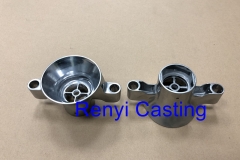Casting can be defined as a process of manufacturing, which implies pouring of a ‘liquid’ material into ‘A Mold’ containing a desired shaped hollow cavity, and then made to solidify. The ejection or breaking out of the casting then takes place to get the process completed. The use of casting is ‘forming hot liquid metals’ or numerous metals that are cooled after having the components like clay, plaster, concrete, and epoxies mixed. Complex shapes are normally made by casting, as other methods are not feasible. Casting came into being around 6000 years ago. ‘Copper Frog’ is the most ancient casting existing till date since 3200 BC. The process of casting has two distinct subdivisions: non-expendable and expendable mold casting.

‘Non-expendable’ mold casting: This technique is inclusive of at least 4 distinct methods: continuous, centrifugal, die, and permanent casting.
Continuous casting: Continuous casting can be defined as a refined process of casting for high-volume, continuous production of ‘metal sections’ with constant cross-section. The pouring of molten metal into a water-cooled, open-ended copper mold takes place. This allows a ‘layer’ of ‘solid metal’ to be formed above the ‘still-liquid’ center. Continuous casting is widely accepted due to its cost-effectiveness. The metals continuously cast are aluminum, copper, and steel.
Centrifugal casting: Centrifugal casting is independent of both-pressure and gravity. This is because its own ‘force feed’ is created by the way of using a ‘temporary sand mold’ in ‘spinning chamber’ at 900 N. Lead time is variant with respect to application. True- and semi-centrifugal processing allow 30 to 50 pieces/hr. The batch processing has an upper limit of around 9000 Kg (practically). This method used to be applied for ‘Casting of Railway Wheels’. It was developed by the company called ‘Krupp’. It had a German origin. Jewelry is normally cast by this method.
Die-casting: Die casting can be defined as a process of ‘forcing molten metal’ into cavities of mold under high pressure. These castings comprise of nonferrous metals, especially-alloys of aluminum, copper, and zinc. It is even possible to make die casting china supplier of metal. The method of die casting is used where finer parts are needed.
‘Permanent Mold Casting’: This casting is made up of non-ferrous metals. It requires some time to set up (some weeks), after which the production rate of about 5 to 50 pieces/hour-mold is achieved. The coating of ‘acetylene soot’ is applied to steel cavities. This helps in removing the work piece easily and promoting longer life (of tools). Permanent molds possess a limited life span. For worn molds, replacement or refinishing is required.
Expendable mold casting: ‘Expendable Mold casting’ can be referred to as a standard classification inclusive of the following:
Sand casting: It is among st the simplest and most popular casting types used since ages. It involves very small size operations. The bonding of sand takes place by use of clay (as in ‘green sand’) or ‘polymerized oils’, or ‘chemical binders’. Recycling is easily possible.
Plaster casting (for metals): There is no difference between plaster casting and sand casting, except the fact that plaster is used in place of sand. Similarly Psychology Articles, there are also plastic and concrete castings.
For More Information Click Here: Aluminum Die Casting
|

